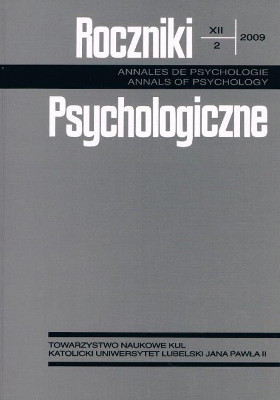Victimization in childhood as a factor related to high-risk behaviors in adolescence
Abstract
The aim of this study was to determine the relationship between childhood experiences of violence and health- or life-threatening high-risk behaviors among Polish adolescents. The studied group consisted of 14-18 year old patients from several Polish centers treating young people with high-risk behaviors. Early Trauma Inventory (ETI) and the Scale of Healthy Behaviors were used in the study. Results: Young people after suicidal attempts and with substance abuse reported predominantly experiences of physical violence in childhood. Adolescents with eating disorders had experienced emotional and sexual violence.
References
Bifulco, A., Moran, P. M., Baines, R., Bunn, A., Stanford, K. (2002). Exploring psychological abuse in childhood. II: Association with other abuse and adult clinical depression. Bulletin of the Menninger Clinic, 66, 3, 241-258.
Briere, J. N. (1992). Child abuse trauma: Theory and treatment of lasting effects. Newbury Park: Sage.
Bryer, J. B., Nelson, B. A., Miller, J. B., Kol, P. A. (1987). Childhood sexual and physical abuse as factors in adult psychiatric illness. American Journal of Psychiatry, 144, 11, 1426-1430. Brzozowska, A. (2004). Krzywdzenie dzieci jako czynnik ryzyka zachowań samobójczych - przegląd literatury. Psychiatria Polska, 25, 1, 29-36.
Cekiera, Cz. (1985). Patologia rodziny w środowisku narkomanów, alkoholików i samobójców. Zdrowie Psychiczne, 2, 5-12.
Cekiera, Cz. (1993). Psychoprofilaktyka uzależnień oraz terapia i resocjalizacja osób uzależnionych. Lublin: Redakcja Wydawnictw KUL.
Crittenden, P. (1988). Family and dyadic patterns of functioning in maltreating families. W: K. Brown, C. Davies, P. Stratton (red.), Early prediction and prevention of child abuse (s. 6883). Chichester: Wiley.
De Young, M. (1982). The sexual victimization of children. Jefferson: McFarland.
Farmer, E., Owen, M. (1995). Child protection practice: Private risk and public remedies - decision making, intervention and outcomes. London: Protection Work HMSO.
Hart, S. N., Brassard, M. R., Karlson, H. C. (1996). Psychological maltreatment. W: J. Brier, L. Berliner, J. A. Bulkley, C. Jenny, T. Raid (red.), The APSAC handbook on child maltreatment (s. 72-89). Thousand Oaks: Sage Publications Inc.
Herman, J. L. (1981). Father-daugher incest. Cambridge: Harvard University Press.
Hund, A. R., Espelage, D. L. (2006). Childhood emotional abuse and disordered eating among undergraduate females: Mediating influence of alexithymia and distress. Child Abuse & Neglect, 30, 4, 393-407.
Kent, A., Waller, G. (2000). Childhood emotional abuse and eating psychopathology. Clinical Psychology Review, 20, 887-903.
Kent, A., Waller, G., Dagnan, D. (1999). A greater role for emotional than physical or sexual abuse in predicting disordered eating attitudes: The role of mediating variables. International Journal of Eating Disorders, 25, 159-167.
Marek, T., Noworol, C. (1987). Zarys analizy skupień - niehierarchiczne i hierarchiczne techniki skupiania. W: J. Brzeziński (red.), Wielozmiennowe modele statystyczne w badaniach psychologicznych. Warszawa-Poznań: PWN.
Marzec-Tarasińska, A. (1998). Sytuacja rodzinna młodzieży zażywającej środki odurzające. Stalowa Wola: Oficyna Wydawnicza Fundacji Uniwersyteckiej w Stalowej Woli.
Miller, B. A., Downs, W. R. (1995). Violent victimization among women with alcohol problems. W: M. Galanter (red.), Recent developments in alcoholism. Vol. 12: Women and alcoholism (s. 267-285). New York: Plenum.
Moran, P. B., Vuchinich, S., Hall, N. K. (2004). Associations between types of maltreatment and substance use during adolescence. Child Abuse & Neglect, 28, 565-574.
Ney, P. G., Fung, T., Wickett, A. R. (1993). Child neglect: The precursor to child abuse pre- and perinatal psychology. Pre- & Perinatal Journal, 8, 2, 95-112.
Piotrowski, A. (1976). Niektóre psychospołeczne determinanty przyjmowania przez młodzież środków odurzających w latach 1969-1973. W: M. Jarosz (red.), Wybrane zagadnienia patologii rodzinnej (s. 150-151). Warszawa: GUS.
Pope, H. G., Hudson, J. I. (1992). Is childhood sexual abuse a risk factor for bulimia nervosa? American Journal of Psychiatry, 149, 455-463.
Root, M. P. (1989). Treatment failures: The role of sexual victimization in women’s addictive behavior. American Journal of Orthopsychiatry, 59, 542-549.
Salter, A. C. (2003). Pokonywanie traumy. Jak zrozumieć i leczyć dorosłe ofiary wykorzystywania seksualnego w dzieciństwie. Poznań: Media Rodzina.
Simpson, T. L., Miller, R. W. (2002). Concomitance between childhood sexual and physical abuse and subsance use problems. A review. Clinical Psychology Review, 22, 27-77.
Smolak, L., Murnen, S. K. (2002). A meta-analitic examination of the relationship between child sexual abuse and eating disorders. International Journal of Eating Disorders, 31, 136-150.
Stankowski, A. (1988). Narkomania - narkotyki - narkomani. Katowice: Uniwersytet Śląski.
Teicher, M. H., Samson, J. A., Polcari, A., McGreenery, C. E. (2006). Sticks, stones, and hurtful words: Relative effects of various forms of childhood maltreatment. The American Journal of Psychiatry, 163, 6, 993-1000.
Thompson, A. E., Kaplan, C. A. (1996). Childhood emotional abuse. British Journal of Psychiatry, 168, 143-148.
Wilsnack, S. C. (1984). Drinking, sexuality, and sexual dysfunction in women. W: S. C. Wilsnack, L. J. Beckman (red.), Alcohol problems in women (s. 189-227). New York: Guilford Press.
Wonderlich, S. A., Brewerton, T. D., Jocic, J., Dansky, B. S., Abbott, D. W. (1997). Relationship of childhood sexual abuse and eating disorders. Journal of the American Academy of Child and Adolescent Psychiatry, 36, 1107-1115.
Copyright (c) 2009 Roczniki Psychologiczne

This work is licensed under a Creative Commons Attribution-NonCommercial-NoDerivatives 4.0 International License.


